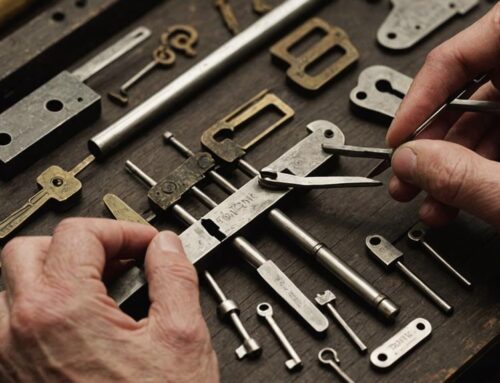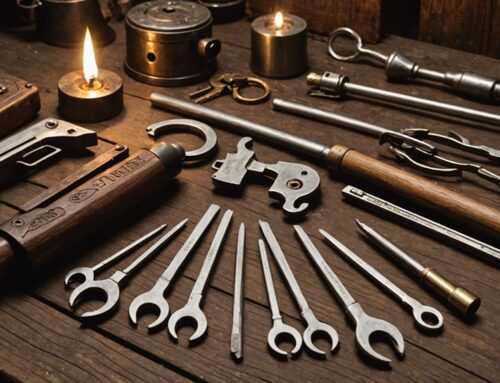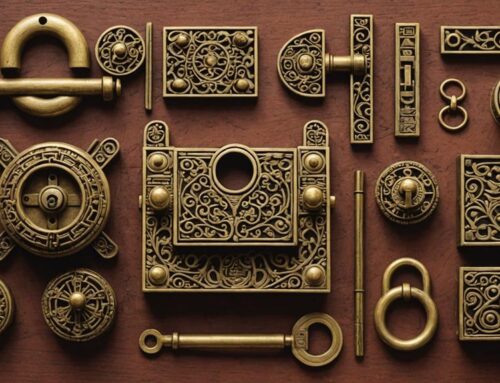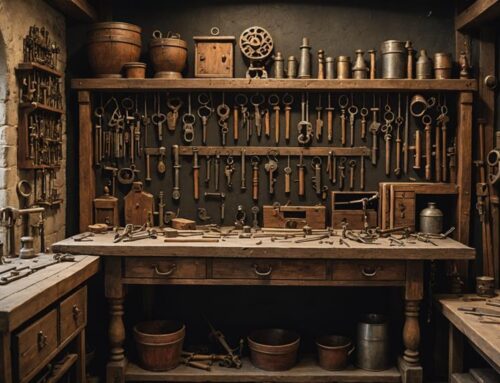You’re standing at a locked door, keyless and frustrated. Don’t fret! With a bit of know-how and everyday items, you’ll soon crack open that door. This guide’s here to show you the ropes, specifically for pin tumbler locks. You’ll learn to craft your own lock-pick, identify the binding pin, and unlock that pesky door. Patience is key, but with each try, you’re mastering a handy new skill. Ready to dive in? Let’s get unlocking.
Key Takeaways
- Pin tumbler locks are one of the most secure locks.
- Pin tumbler locks consist of a plug, pins, housing, and shear line.
- Creating a lock-pick using a long, thin item like a bobby pin or paper clip.
- Identifying the binding pin and gently pushing it up with a tension wrench.
Understanding the Basics of Locks
In understanding the basics of locks, you’ll need to grasp that pin tumbler locks, one of the most secure types, consist of a plug, pins, housing, and a shear line. It’s like an intricate puzzle waiting to be solved. Exploring the history of lock picking techniques, you’ll find that it’s not just about breaking in, but is more about understanding the different types of locks and their inner workings. You’re not just a casual observer, but a part of an age-old tradition of locksmiths and hobbyists. With each lock you pick, you’re stepping into a fellowship that values patience, persistence, and practical knowledge. So don’t just learn to pick a lock, understand it. It’s not just a skill, but a journey you’re embarking on, where every lock picked is a milestone.
The Art of Creating Your Own Lock-Pick
You’ll need to gather a long, thin item like a bobby pin or paper clip to create your own lock-pick, and remember, it’s all about patience and creativity. Precision is vital in lock picking, as the alignment of the pins determines the lock’s opening.
Here are some tips to remember:
- The lock-pick must be thin enough to enter the keyhole.
- Apply gentle pressure when moving the pins, excessive force may damage the lock.
- Listen for the subtle ‘click’ when the pin reaches the shear line.
- Keep your tool steady, precision can’t be compromised.
- Experiment with unconventional tools, they can offer advantages in flexibility and size.
Embrace the art of lock picking, it’s a skill that promotes patience, precision, and resourcefulness.
The Role of Pins in a Lock
Understanding how pins work within a lock can give you a significant advantage when trying to pick it. An integral part of this process is realizing the importance of pin placement.
| Pin Type | Role in Lock |
|---|---|
| Key Pin | Matches key cuts |
| Driver Pin | Creates shear line |
| Binding Pin | First to unlock |
Manipulating pin tumblers is about finesse, not force. You’ve to push the binding pin up with your tool, maintaining a delicate pressure. This separates the driver pin from its key pin. Once set, move onto the next pin.
Crafting and Using a Tension Wrench
Most of your success in lock picking depends on how you craft and use a tension wrench. Crafting a tension wrench involves bending a sturdy piece of metal, such as a paperclip, into an L shape. This tool is your key to manipulating the lock. Here’s how you can use a tension wrench effectively:
- Insert the short end of your tension wrench into the bottom of the keyhole.
- Apply slight pressure in the direction the key would turn.
- Maintain this tension while picking the pins.
- Feel for the binding pin and set it.
- Repeat until all pins are set and the lock turns.
Identifying and Utilizing the Binding Pin
In your next step, you’ve got to identify the first binding pin, which is typically the one farthest from the plug’s centerline. By gently pushing it up with your tension wrench, you’ve already begun the process of unlocking the door. Don’t be hasty though. Applying and maintaining just the right amount of tension is key to keep the pins separated.
| Steps | Tips |
|---|---|
| Identify Binding Pin | It’s the farthest from plug’s centerline |
| Utilize Tension | Carefully, maintain pressure |
| Separate Pins | Twist the plug lightly |
| Repeat for All Pins | Patience is key |
| Unlock | Celebrate your achievement |
Identifying the binding pin accurately and utilizing tension to keep pins separated are the hallmarks of a successful locksmith. Remember, you’re part of a larger locksmith community, and your success depends on your patience, accuracy, and practicality.
The Technique of Turning the Plug
You’ll need to turn the plug slightly to separate the driver pin from the key pin, keeping a steady hand to maintain tension. This is the essence of the turning technique, a fundamental skill in lock-picking. Understanding this technique and mastering the proper turning motion is crucial to your success.
Consider these aspects:
- Your turning pressure should be light and consistent.
- Overturning may cause the pins to bind in the wrong order.
- Practice makes perfect. Don’t get frustrated if it doesn’t work at first.
- Experiment with alternative methods. For example, try different household items as tension wrenches.
- Remember, lock-picking is an art of finesse, not force.
Don’t just follow the crowd. Mastering this skill gives you a sense of belonging and accomplishment. Your journey into lock-picking is just beginning. Keep exploring, keep learning.
The Process of Setting a Pin
Once you’ve separated the driver pin from the key pin by turning the plug, that’s when the process of setting a pin really begins. Implementing the setting pin technique, you maintain tension on the plug. This stops the driver pin from slipping back down, ensuring the key pin remains in place.
Now, you’re part of an exclusive group that understands this intricate task. While you’re becoming adept at setting pins, don’t forget to explore alternative lock picking methods. They’re just as valuable, offering you a variety of approaches to unlock doors. Remember, practice makes perfect, so don’t be disheartened if success doesn’t come instantly. You’re learning a unique skill, one that requires diligence, patience, and a keen sense of touch. Keep going, you’re doing great.
How to Pick a Lock With Household Items
Someone might think it’s impossible, but you can actually pick a lock with items you’ve got lying around the house. It’s all about knowing your tools and the lock you’re dealing with. Now, picking a lock without damaging it requires skill and a gentle touch:
- First, you need to create a makeshift lock pick. A straightened paperclip or hairpin works perfectly.
- Second, make a tension wrench from a similar item.
- Apply gentle pressure with your wrench, locate the binding pin, and lift it using your pick.
- Repeat this process, setting each pin in the lock.
- Remember, patience is key.
Congratulations, you’re picking a lock with unconventional tools, and you’re part of an exclusive group of DIY lock pickers.
Tips and Tricks for Successful Lock Picking
In order to master lock picking, it’s critical that you understand the mechanism of the lock you’re working with. Overcoming lock picking obstacles starts with knowing the ins and outs of your target lock. Each pin, plug, and shear line plays a role, and understanding these components is your first step to success. Advanced lock picking techniques build on this knowledge. It’s not just about having the right tools, it’s knowing how to use them. You’ll need to feel the binding pin, apply just the right amount of tension, and carefully set each pin. Remember, it’s a skill that takes patience and practice. You’re part of a community of lock pickers, always learning and perfecting the craft. Keep trying, and you’ll soon find those previously insurmountable locks opening with ease.
Overcoming Common Challenges in Lock Picking
You’re tackling common lock picking challenges, but remember, patience and practice are key to mastering this skill. Overcoming frustration is part of the journey, and it’s okay to feel stuck sometimes – that’s how you grow.
- Don’t rush the process. Each lock is unique and requires a different approach.
- Keep practicing, even if progress seems slow. Consistency is crucial.
- Remember to breathe. Frustration can make you tense, which can affect your technique.
- Don’t be afraid to take breaks. Clearing your mind can often lead to breakthroughs.
- Celebrate small victories. Every pin you set is a step closer to mastering the technique.
Frequently Asked Questions
What Types of Locks Cannot Be Picked Using Household Items?
Despite your best efforts, some locks resist household item picking. Lock picking limitations arise with unpickable lock designs like disc-detainer, tubular, or certain high-security pin tumbler locks. These require specialized tools and skills.
Are There Any Legal Implications of Lock Picking?
Yes, there’re legal implications to lock picking. While it’s a useful skill, unauthorized lock picking can lead to legal consequences. Always remember, locksmith licensing exists to ensure this skill isn’t misused. Respect others’ privacy.
Is It Possible to Damage a Lock Beyond Repair While Attempting to Pick It?
Sure, when you’re practicing picking techniques, you can potentially puncture a pin or push past the shear line, damaging the lock’s durability. But don’t worry, with careful handling, this risk is significantly reduced.
Can Lock Picking Skills Be Used on Electronic or Code-Based Locks?
While you’ve mastered mechanical locks, digital security’s a different game. You can’t pick electronic or code-based locks traditionally. Remember, hacking into these requires knowledge on coding and also raises ethical issues. Stay informed and respectful.
What Are Some Safety Precautions to Take When Trying to Pick a Lock?
Always prioritize safety when picking locks. Wear protective gear like safety glasses to prevent eye injuries from any potential flying metal pieces. Remember, you’re part of a community that values safety first.








